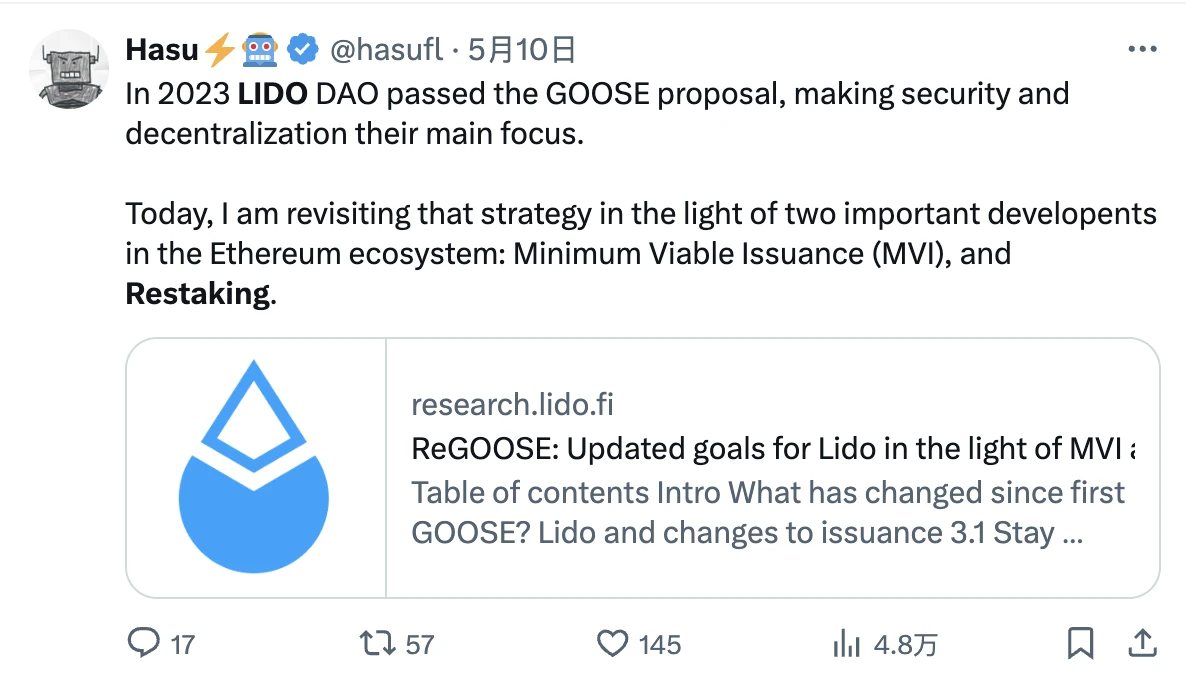原作者:リド戦略コンサルタント蓮
編集:オーデイリープラネットデイリーアズマ
先週末、リドの戦略顧問ハス氏は最初の更新意見(再GOOSE #1 )は、過去6か月間の市場環境の変化に対応して昨年10月に決定されたLidoの「戦略的意図」(GOOSE)に基づいています。
記事の中で、蓮氏は、リド社が現在直面している 2 つの主な課題について言及しました。
-
初め、 イーサリアム財団の研究者らは、イーサリアムネットワークのステーキングインセンティブを大幅に削減することについて議論を始めており、これはリドのような分散型ステーキングプロトコルの経済的利益を根本的に脅かす可能性がある。 ;
-
第二に、再ステーキングの物語の発展により、EigenLayerやLRTなどのプロジェクトによる補助金が数百億ドルの資本流入を引き起こしました。その結果、stETHは受動的に吸血鬼攻撃を受け、その市場シェアは32%から29%に低下しました。 .
上記 2 つの課題に直面して、Hasu 氏は自身の理解とコミュニティの議論を組み合わせて、常に変化する市場の動向に Lido がどのように対応すべきか、どの側面で積極的に変化を求めるべきか、どの側面で当初の意図を貫くべきかについて、独自の提案を行いました。
この記事では、Hasu 氏が挙げた 2 番目の課題、つまり、Lido が Restaking に対する吸血鬼の攻撃の問題をどのように解決するかに焦点を当てます。 最初の課題については、イーサリアム財団はメインネットのステーキングインセンティブを変更するかどうかについてまだ一般的な合意に達していないため、この提案はまだ研究と議論の段階にあります。Hasu氏はまた、この提案は今後12か月で大きな進展がないと考えているため、この記事では詳しく説明しません。この部分に興味のある読者は、直接フォーラムにアクセスして原文を読むことができます。
以下は、ハスの原文(すべてハスの一人称視点)をOdaily Planet Dailyが翻訳したものです。
リドとリステーキング
リステーキングは、同じ担保を複数の検証サービス(Eigenlayer のコンテキストでは AVS と呼ばれます)で使用できる新しい経済モデルであり、それによって資本利用効率が向上しますが、新しいスラッシング条件の存在により、それに応じてリスクも増加します。たとえば、同じ ETH を Ethereum PoS 検証のステーキング資産として使用したり、データ可用性ノード(EigenDA など)を実行するために使用したりすることもできます。
私は昨年 10 月、Lido が GOOSE を開発していたときに Restaking について議論しました。当時の私の見解は、これは確かに有望な基盤技術ではあるものの、完全に成熟するには何年もかかるかもしれないというものでした。Restaking では追加のペナルティ条件により新たなリスクが生じますが、AVS サービスからの収益は当初はごくわずかです。
しかし、 上記の分析では、EigenLayer がリリース前の段階で物語を大げさに宣伝し、ポイント補助金を利用して事前に資本流入を引き付ける可能性が無視されています。 本稿執筆時点で、ユーザーは合計約500万ETH(約$15億相当)をEigenLayerに預け入れており、そのほとんどはAVSサービスが開始される前から入っていたものです。さらに、EigenLayer周辺の流動性再担保プロトコル(LRT)と他のAVSパートナーも独自の補助金プランを持っているため、これも再ステーキングの物語に対するインセンティブをさらに高めるのに役立っています。
これらの補助金は長期的には持続不可能になる運命にあるものの、現状では、多くのステーキングユーザーが、stETH のより高いセキュリティとそのネットワーク効果よりも、Eigenlayer + LRT のより高いリターンを選択し始めています。
このような状況を受けて、私は以下の3つの側面からGOOSEのアップデート提案をさせていただきます。
stETHはLSTとして存在し続け、LRTに変換されるべきではない。
Restaking/LRT の物語が現在人気があるにもかかわらず、私は 2 つの理由から stETH を LRT に変換すべきではないと考えています。
まず、GOOSE のオリジナル版で述べられているように、今後 3 年間で、個人資本よりも多くの機関資本が Ethereum に参加することが予想されます。Ethereum のステーキング レイヤーが十分に分散化されたままであり続けるためには、Lido やその他の分散型ステーキング プロトコルが機関投資家の支持を得ることが重要です。私の個人的な経験では、LRT の高リスクとアクティブに管理される性質は、機関投資家のリスク許容度を満たしていません。 stETH の場合、資金を大量に蓄積することで最も安全で流動性の高い LST となり、LRT に変換してさらなるリスクを加えると、この基盤が損なわれます。
第二に、LRT はより高い利回りを提供できますが、その性質は ETH 建ての投資信託や貸付市場におけるトークン化された預金に近いものです。流動性ステーキングの主な特徴は、コモディティ化されたソフトウェア製品であることです。しかし、LRT の場合、市場のほとんどの人にとって、リスクとリターンの好みを一致させることは難しいかもしれません。 したがって、LRT は大きなネットワーク効果と高い流動性を実現する可能性は低く、その採用はさらに制限されるでしょう。さらに、LRT のアクティブ管理の性質により、規制対象の金融サービスと見なされる可能性も高くなります。
しかし、LidoはstETHの上に追加の製品(LRTなど)を構築する可能性を残しておくべきである。 製品に対する市場の需要が Lido のビジョンと一致している限り、stETH 自体は Lido の基盤として常に LST のままである必要があります。
「事前確認」などのスラッシュリスクを排除できるステーキングサービスを探す
LRT を別にすれば、2 つの理由から、バリデータ サービスに関する stETH のユースケースをさらに深く検討することもできます。
-
理由の 1 つは、AVS はバリデータを必要とする AVS とバリデータを必要としない ASV に大別でき、後者はあらゆるタイプの担保に基づいて動作できることです。
-
第二に、すべてのバリデータサービスがスラッシングメカニズムを必要とするわけではありません。言い換えれば、スラッシングリスクは stETH 保有者に影響を与えないように隔離することができます。
Lido は、ステーキングとは何かを定義する最前線に立ち続け、Ethereum の拡張やセキュリティ ビジョンに貢献するバリデータ サービスを積極的に模索し、それによって Ethereum コミュニティのサポートを獲得すべきだと私は考えています。
2022年、Lidoはすべてのノードでmev-boost(プロトコル外PBS)を使用することを約束した最初のステーキングプロトコルになりました。その包括的な戦略は、MEVの最大化、ノードの選択、検閲耐性の間で良好なバランスを実現し、業界全体のステーキングサービスにプラスの影響を与えました。
mev-boostの実行は、現在ではステーキング操作の通常の一部となっています。 ステーキングを構成するものの定義が追加サービスから恩恵を受けることができることを実証します。
私の意見では、事前確認は mev-boost の次に広く採用されるバリデーターサービスになるでしょう (ただし、これは mev-boost の置き換えではなく、進化したものになると予想しています)。 事前確認により、バリデーターは現在のブロック内のすべてのトランザクションに加えて追加のトランザクションを含めることを約束できるため、ロールアップまたは DEX トランザクションをより速く順序付けることができ (次のブロックの 12 秒の時間と比較して)、ユーザー エクスペリエンス、セキュリティ、相互運用性など、さまざまな側面が向上します。
Lido は事前確認サービスのリーダーとなり、パートナーを探し始めるべきです。また、Lido は、stETH 保有者にさらなるリスクをもたらすオプションを選択するのではなく、新しいサービスごとに設定された特別な資金を使用してこの目標を達成する必要があることにも留意する必要があります。
stETHをRestaking市場におけるトップ担保に押し上げる
イーサリアムのビジョンに沿ったバリデータサービス(「事前確認」など)を社内で検討することに加えて、 また、stETHがさまざまなAVSの第一担保となる機会にもなるだろう。 バリデータを必要としないか、リスクが高すぎるか Ethereum のビジョンと一致しないためにプロトコル内に構築できないもの。
この選択は、stETH を最も安全でイーサリアムに最も適した LST として維持するという基本原則に沿ったものです。Lido は積極的なリスク管理の分野に参入すべきではありませんが、誓約者が stETH を Restaking プロトコルまたは AVS に預けることで、より高いリスク/リターン モデルを選択できる方法を見つける必要があります。
これには、stETH を中心としたアプリケーションとパートナーの活気あるエコシステムの構築が必要です。これは、エコシステム構築のカテゴリに分類される、Ethereum DeFi とより広範な CeFi スペースへの統合によって Lido が行ったことと同様です。これには、Lido が AVS および LRT エコシステムを深く理解し、システム内の主要なプレーヤーとのつながりを構築し、コラボレーションを通じてインセンティブを調整することも必要です。
Lido はこれまで戦略的パートナーシップの交渉において実績が乏しかったため、この目的のために Lido 内に新しいエコシステム構築チームを設置することをお勧めします。
この記事はインターネットから引用したものです: Restaking の「ヴァンパイア」攻撃を受けた Lido はどのようにして問題を解決できるのでしょうか?
関連: Avalanche (AVAX) 価格予測: $70 に到達できるか?
要約 Avalanche (AVAX) の価格は、過去 7 日間で 21.93% 上昇しました。最近の急騰にもかかわらず、RSI は依然として健全であり、さらなる成長が期待できます。現在、利益を上げている保有者の数は 75% です。過去のデータによると、これが AVAX の転換点です。過去 1 週間、Avalanche (AVAX) の価格は大幅に上昇し、21.93% の成長を記録しました。最近の急騰にもかかわらず、相対力指数 (RSI) は健全であり、AVAX がさらに成長する可能性があることを示唆しています。現在、75% の AVAX 保有者が利益を上げています。過去のデータによると、このレベルは AVAX にとって重要な転換点となることが多く、資産が将来のパフォーマンスにとって極めて重要な瞬間にあることを示しています。AVAX RSI は 70 に近づいていますが、…









